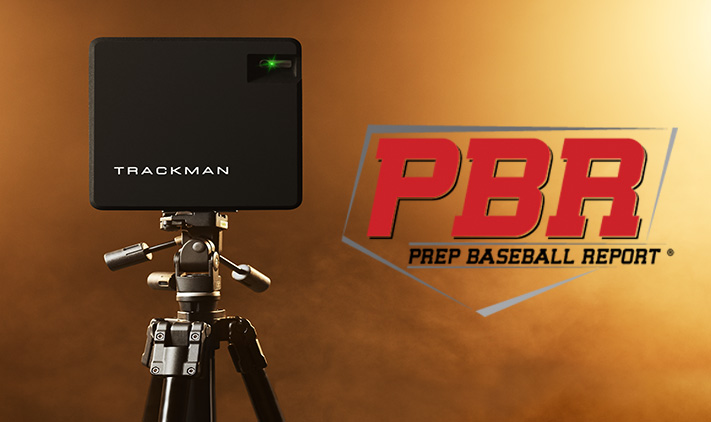Mid-Atlantic ProCase: Trackman Traits (Part 2)
March 25, 2021
Follow @PBRVirginiaDC
Facebook + Instagram
The expanded usage of data, and the importance of it in regards to player development and player assessment is a legitimate, undeniable tool used by high school, college, and professional teams across the country. Today we break down some of the data from our recent Mid-Atlantic ProCase event in Richmond, VA.
Glossary Terms Intro & Links:
Induced Vertical Break: VB or IVB
Vertical Approach Angle: VAA
Horizontal Break: HB
Release Speed: RS or Velo
Release Height: RH or RelHei
Fastball: Touched 87.3, averaging out at 85.7 mph. His flattest in-zone VAA was 4.3 degrees, 0.2 inches from the top of the zone. This pitch had one of his more lateral tilts on the day, and produced just 13.8 inches of VB, which means his VAA could have been flatter had he gotten more vertical movement. Because he has such a low release height (5.04 feet), he’s able to pitch up. Though he does have below average VB (14.5 inches of VB), he’d benefit from shifting his axis one-fourth of an hour vertically as his most of his tilts were in the 10:30/10:45 area.
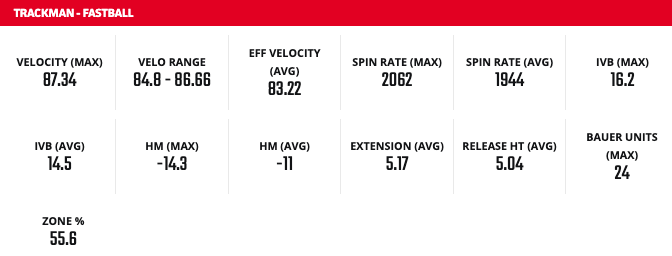
Curveball: Mix of a sweeper/slurve. Threw it at 3:30/4:00 with about -5.8 inches of vertical drop (the slurve element), and 15.6 inches of horizontal break (the sweeper element). Averaged 2,064 rpm on it, with one as high as 2,359 rpm; which had both more vertical drop and sweep.
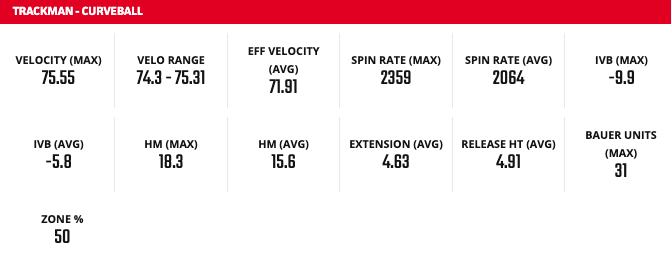
Changeup: Threw it for a strike 50% of the time with 7.9 more inches of HB than VB. Had as much as 17.3 inches of VB on a pitch with just 6 inches of VB (less equals better). Threw it 0.34 feet lower than his fastball which is right around normal, but his extension was 0.6 feet shorter, which is abnormal. Because he threw the pitches for strike, had a 10.9 mph difference to go with really good movement; the differing release isn’t an issue.
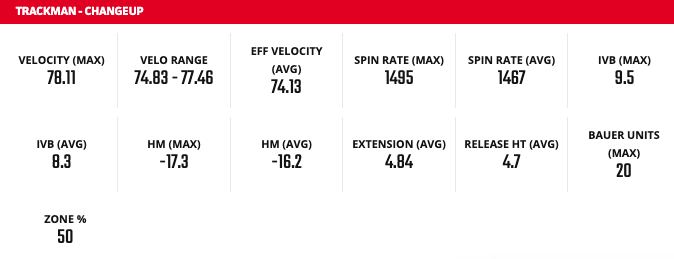
2021 Isaac Fix @isaacfix15 (@Byrd1Sports)
— PBR Virginia/DC (@PBRVirginiaDC) March 21, 2021
Fix, a @prepbaseball #FutureGames alum, has a quick L3/4 arm. Feel for both secondary pitches and the CB has late 1/7 shape. @DavidsonBASE commit.
FB 85-87
CB 74-76
CH 75-78#MidAtlanticProCase pic.twitter.com/Mhy1m8qAT4
Fastball: Touched 89.3 mph with his highest spin rate being 2,318 rpm. Threw it at 1:30 (dead zone for righties) so he gets equal-parts movement-wise with 15 inches of VB and 15.6 inches of HB. Most lateral tilt was 2:00 with 11 inches of VB and 18.9 inches of HB. His most vertical tilt was 1:15 which had 17.5 inches of VB to go with 12.9 inches of HB. Had third lowest release height of the event at 4.82. If he can throw his fastball vertically from 1:30, he’d have an effective pitch up in the zone. Threw it in the zone 30% of the time.

Slider: Sweeper profile. Little to no top spin, almost entirely side spin with heavy gyro spin. Threw it at 9:00. Averaged 0.8 inches of VB to go with -14.6 inches of HB. Touched 78.4 mph but sat around 77 mph. Didn’t throw it for a strike. Had an average spin rate of 2,330 rpm. The majority of his tilts were around 9:00 which means his wrist orientations don’t differ from pitch-to-pitch: a good trait for a high schooler who throws numerous breaking balls.

Curveball: Slurve profile. More sweep than his slider, but much more vertical drop (7 inches). Threw it 3.6 mph slower than his slider with a touch less raw spin. Tilts were around 8:15, an hour counter-clockwise from the slider.
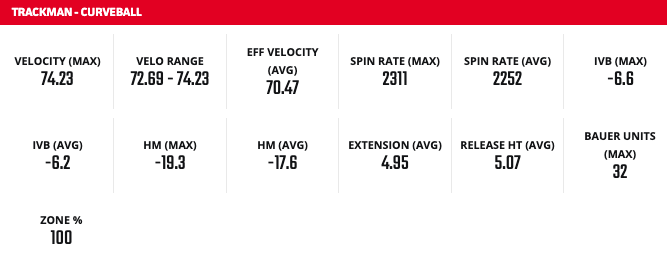
Changeup: Averaged the most HB of any pitcher, but didn’t throw the pitch for a strike once. Most HB on a single-pitch was 20.3 inches, while he averaged 19.2 inches. Threw it an hour clockwise from his fastball with a 5 mph, 278 rpm difference.

2023 John Glasscock @GlasscockJj (@FluvannaB)
— PBR Virginia/DC (@PBRVirginiaDC) March 22, 2021
The @prepbaseball #FutureGames alum & @WVUBaseball commit is an athletic mover on the mound. Big arm speed through release and a FB that has life through the zone.
FB 87-89
CB 73-74
SL 76-78
CH 80-85#MidAtlanticProcase pic.twitter.com/7W3L1kCbe8
Fastball: Combined the lowest release height of the event (4.53) with the fourth hardest fastball on average (90.3 mph), this gives him an extremely flat VAA. Because he threw it for a strike just 33.3% of the time, and zero at the top of the zone, you have to prorate the pitch as if it was thrown at the top of the zone (3.5 PlaLocHei). Doing this with his lowest actual VAA (4.3 degrees), you’d get a 3.48 VAA. The fact that his VAA is this low with below average VB (14.9 inches) means there’s even more potential for a flatter VAA. His highest VB was 17.7 inches with a 1:15 tilt. Constantly throwing it vertically from 1:30 would help him out a ton.

Curveball: Dropped it in the zone 33.3% of the time with a sweeper look. Had -2.4 inches of VB with -8.3 inches of HB and a release height 0.3 feet lower. Threw it at 75.4 mph touching 96.7 with a max raw spin of 2,125 rpm and an average of 2,042 rpm. Tilts ranged from 8:15 to 8:45 with his best coming at 8:30 (most sweep). Similar raw spin to his fastball.
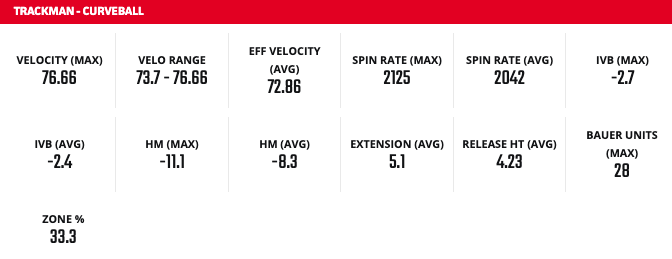
Splitter: Extremely low raw spin (873 rpm on average), heavy pronation. Kills spin really well with little to no back spin and heavy side spin. Slight gyro spin but mostly true spin. Threw it in the zone 16.7% of the time. Splitters are harder to evaluate because there’s less research/data on them, but similar to changeups: you need to throw it for a strike, limit back spin and pair high efficiency with heavy HB. Keller does the last three, but not the first one. If he can do the first one, it’s an out-pitch.
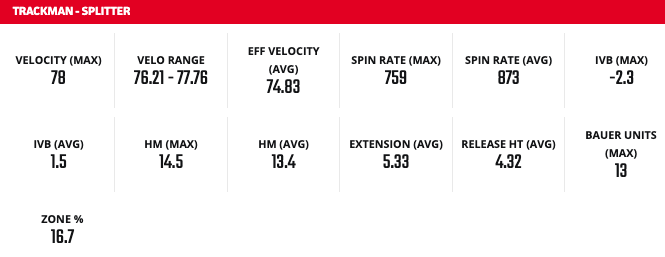
2022 Seth Keller @keller2022 (@HanoverBaseball)
— PBR Virginia/DC (@PBRVirginiaDC) March 22, 2021
The @ODUBaseball commit that had a strong 2-way day. Feel for 3 pitches and worked down in the zone.
FB 90-91
CB 73-77
SPL 76-78@prepbaseball #MidAtlanticProcase pic.twitter.com/AebK0vQOyA

